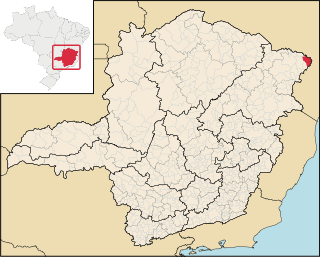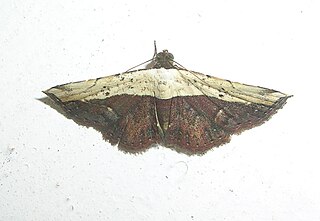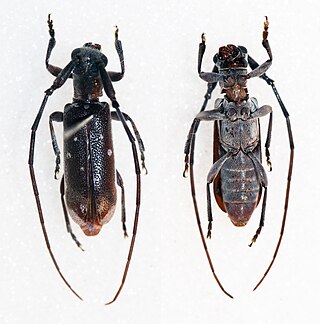
Águas Vermelhas is a city in the northeast of the Brazilian state of Minas Gerais. In 2020 its population was estimated to be 13,599 in a total area of 1,258 km².

Salto da Divisa is a municipality in the northeast of the Brazilian state of Minas Gerais. Its population in 2020 was 7,012 inhabitants in a total area of 943.647 km2. It is the easternmost municipality of Minas Gerais

Santa Maria do Salto is a municipality in the northeast of the Brazilian state of Minas Gerais. Its population in 2020 was 5,217 inhabitants in a total area of 442 km2.

Divisa Alegre is a Brazilian municipality located in the northeast of the state of Minas Gerais. As of 2020 the population was 6,868 in a total area of 118 km².

Euphyllia divisa, commonly known as frogspawn coral and sometimes misspelled Euphyllia divisia, is a large-polyped stony coral native to the Indo-Pacific islands. It is a commonly kept species in the marine aquarium hobby. The related coral Fimbriaphyllia paradivisa is frequently misidentified as frogspawn leading to some confusion. Fimbriaphyllia divisa has a corallite skeleton with a flabello-meandroid "wall" structure whereas Fimbriaphyllia paradivisa has a tree-like branching structure with separate corallites.
The National Center for Foreign Commerce, formerly the Commission for the Administration of Currency Exchange, is the Venezuelan government body which administers legal currency exchange in Venezuela. The official buy/sell exchange rate was initially fixed at Bs.F. 4.28/Bs.F. 4.30 per US dollar (USD).

Oruza divisa is a species of moth of the family Erebidae first described by Francis Walker in 1862. It is found in Asia, including Hong Kong, Sri Lanka, Sulawesi, Taiwan, Japan and in Africa south of the Sahara, including Indian Ocean islands.

Eunidiini is a tribe of longhorn beetles of the subfamily Lamiinae. It was described by Téocchi et al. in 2010.

Eunidia is a genus of longhorn beetles of the subfamily Lamiinae.
Eunidia fallaciosa is a species of beetle in the family Cerambycidae. It was described by Stephan von Breuning in 1939. It is known from Somalia.
Eunidia flavoapicata is a species of beetle in the family Cerambycidae. It was described by Stephan von Breuning in 1939.

Eunidia tripunctata is a species of beetle in the family Cerambycidae. It was described by Per Olof Christopher Aurivillius in 1911.
Eunidia plagiata is a species of beetle in the family Cerambycidae. It was described by Charles Joseph Gahan in 1898. It is known from Chad, Kenya, Zimbabwe, Mozambique, Ethiopia, South Africa, Botswana, and Tanzania.
Eunidia subtesselata is a species of beetle in the family Cerambycidae. It was described by Charles Joseph Gahan in 1909. It is known from Kenya, Ethiopia, and Somalia.
Eunidia batesi is a species of beetle in the family Cerambycidae. It was described by Olliff in 1889.
Eunidia nebulosa is a species of beetle in the family Cerambycidae. It was described by Wilhelm Ferdinand Erichson in 1843. It is known from Australia, Senegal, Cameroon, Gabon, the Democratic Republic of the Congo, South Africa, Madagascar, Ethiopia, Ivory Coast, Kenya, Namibia, Angola, Niger, Saudi Arabia, Somalia, Mozambique, Tanzania, and Zimbabwe.

Eunidia thomseni is a species of beetle in the family Cerambycidae. It was described by William Lucas Distant in 1898. It is known from Tanzania, Cameroon, Chad, Niger, Ethiopia, Senegal, Mozambique, Botswana, Namibia, Saudi Arabia, the Central African Republic, Somalia, Uganda, South Africa, Yemen, Kenya, and Zimbabwe.

The Immediate Geographic Region of Pedra Azul is one of the 7 immediate geographic regions in the Intermediate Geographic Region of Teófilo Otoni, one of the 70 immediate geographic regions in the Brazilian state of Minas Gerais and one of the 509 of Brazil, created by the National Institute of Geography and Statistics (IBGE) in 2017.

The Immediate Geographic Region of Almenara is one of the 7 immediate geographic regions in the Intermediate Geographic Region of Teófilo Otoni, one of the 70 immediate geographic regions in the Brazilian state of Minas Gerais and one of the 509 of Brazil, created by the National Institute of Geography and Statistics (IBGE) in 2017.

The Immediate Geographic Region of Alfenas is one of the 10 immediate geographic regions in the Intermediate Geographic Region of Varginha, one of the 70 immediate geographic regions in the Brazilian state of Minas Gerais and one of the 509 of Brazil, created by the National Institute of Geography and Statistics (IBGE) in 2017.











